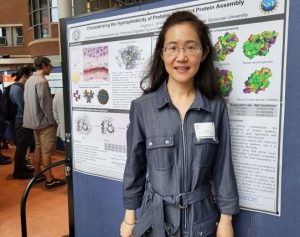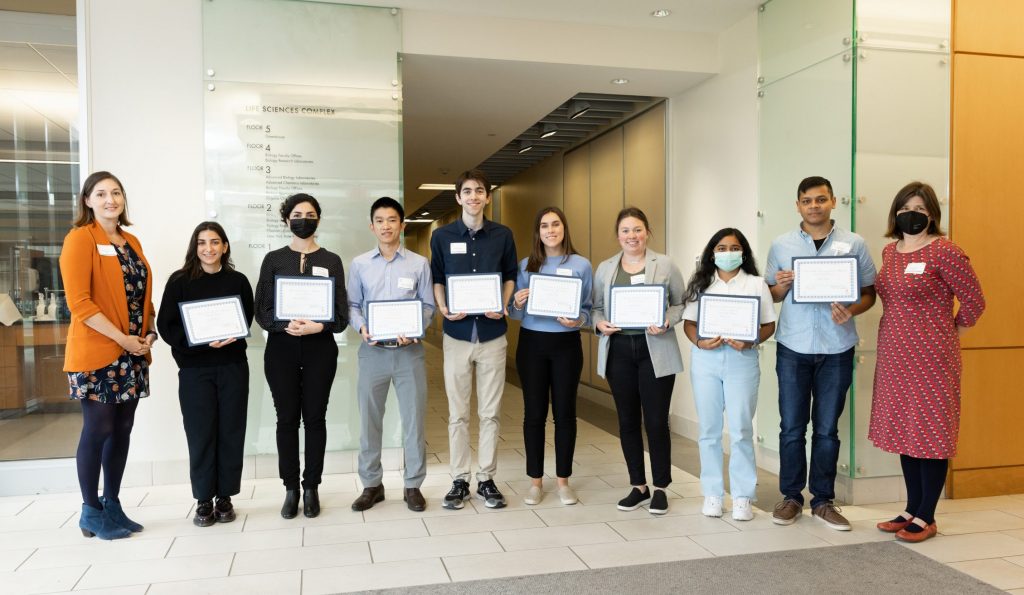Energy. Excitement. Enthusiasm. Opportunity.
Those words convey the atmosphere evident at last week’s inaugural BioInspired Institute symposium and the sentiments of students, faculty, staff, University leaders and external stakeholders attending the event to describe the research cluster’s efforts of the past three-plus years.
In celebration of academic excellence and institutional collaboration, nearly 140 attendees overflowed the Life Sciences Building atrium, where 57 undergraduate and graduate students and post-doctoral fellows presented posters illustrating their interdisciplinary research projects. The work of institute members spans the fields of life science, engineering, physics and chemistry and is focused in bioengineering and biomedical projects involving smart materials, development and disease, and cell form and function.
As the first in-person conference the institute has been able to host, the event represented the diversity of projects being undertaken by undergraduate and graduate students and post-doctoral researchers, along with faculty from dozens of interdisciplinary research labs. The unique collaboration features initiatives by faculty and students in the College of Arts and Sciences and College of Engineering and Computer Science, and uniquely also includes researchers and centers at neighboring institutions SUNY College of Environmental Science and Forestry and SUNY Upstate Medical University.
Setting A ‘High Bar’

Chancellor Kent Syverud expressed enthusiasm at how the institute has intertwined diverse interdisciplinary interests, generated projects bridging two University colleges and forged new working relationships among colleagues at three different academic institutions. He said that the institute’s successful evolution is precisely the type of cooperative effort envisioned when the research cluster was first developed and that the College of Arts and Sciences and College of Engineering and Computer Science have “set a high bar for what a collaborative partnership can achieve.” The institute also “has lived up to many dreams already” in work seeking cures for cancer, bioprinting organs and developing smart mesh that communicates medical information, he said. The BioInpsired team is growing quickly too because Invest Syracuse funding has allowed the hiring of 11 new cluster-dedicated faculty this year, with plans in progress to hire 12 more, Chancellor Syverud said.
Vice Chancellor, Provost and Chief Academic Officer Gretchen Ritter said the institute’s pursuits, path and progress, despite two years of COVID challenges since its 2019 founding, is “on this dynamic trajectory that, for me, is a model for a lot of the work that we want to do at the University more broadly.” Ritter said she is deeply encouraged by the institute’s record of training 120 students and post doctoral fellows, engaging over 60 faculty from three different institutions, and significantly boosting the dollar value of grants received. All of those markers “are evidence of the power of this interdisciplinary approach,” she said.
M. Lisa Manning, director of the institute and William R. Kenan Jr. Professor of Physics in the College of Arts and Sciences, enjoyed seeing how the conference facilitated interactions among researchers from various disciplines, allowed visual presentations of the breadth of research underway and generated connections between interdisciplinary collaborators. “Biochemists find they can better understand neurodegenerative diseases when they think about the involved proteins as a material that self-segregates due to physical interactions,” Manning said. “And biomedical engineers can develop better biomaterials for healing wounds by incorporating new anti-microbial compounds.”
Making Connections
Postdoctoral fellow Ashis Sinha, who came to the institute in 2021 after earning a Ph.D. from Upstate Medical University the year before, presented a poster and a lightning talk on how molecular mechanisms contribute to Rhett syndrome pathology and new therapeutic interventions. For him, the symposium presented an opportunity to connect with many other researchers. “I work in a neuroscience/biology lab and to learn about the research being undertaken in the physics and biomaterials divisions was intriguing,” Sinha said. “It was also challenging to prepare my presentations with enough detail to convey the challenges of my project and highlight key findings for a non-biology audience. It was a great learning experience.”

Another presenter, fourth-year doctoral student Jingjing Ji, said participating in the poster session offered the chance to help her learn to communicate about and understand the relevance and importance of her research. She said she appreciated gaining feedback on her work, which looks at the behaviors of elastin-like polypeptides and how proteins repel water. “I am so glad my modeling work was highly praised by the researchers in the poster session. Now, I am developing an interactive web-based online platform to perform the calculations which will offer a user-friendly interface to the research community.”
Win Thurlow, executive director of Syracuse-based biomed industry association MedTech and a BioInspired external advisory board member, said he was impressed by the array of research that is taking place at the institute. “Today has been an exciting day to really witness the depth of the scholarship and to harness the collaborative nature of what’s going on here,” Thurlow said. “It really has the power to be transformative with respect to where we go in the biomed industry and where we go in terms of medical developments. This is exactly the kind of path that we need to take as we look to grow this industry locally, regionally and nationally.”
Remarkable Energy
Jeremy Steinbacher, the institute’s director of operations, echoed that positive assessment. “The enthusiasm and positive energy at the event was remarkable. We truly got a chance to show everyone what we have been doing for the last three-plus years in building community and supporting them with programming,” Steinbacher said. “Hopefully, we set a vision for the future and generated even more enthusiasm for continuing to build the institute.”
Awards were presented for poster and presentation talks. The top poster award went to Maryam Ramezani (biomedical and chemical engineering). Lauren Mayse (biomedical and chemical engineering and physics) was awarded second place; third place went to Nicole Maurici (SUNY Upstate Medical University); and Amber Ford (chemistry) received an honorable mention. Nicholas Najjar (chemistry) was named as the researcher whose project has the best chance of commercialization. His work involves promising therapeutic substances that may help alleviate nausea, emesis and anorexia in patients undergoing chemotherapy. Nghia LeBa Thai (biomedical and chemical engineering) won the Stevenson Biomaterials Award, with Gargi De (civil and environmental engineering) coming in second place. Two awards were given for lightning-talk presentations to Mengfei He (physics) and Ashis Sinha (biology).

